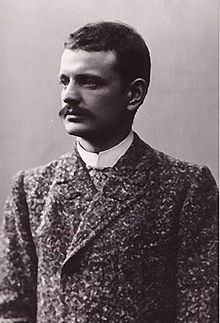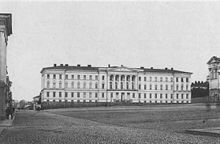| Revision as of 17:41, 14 September 2015 editMcLennonSon (talk | contribs)Extended confirmed users2,167 editsmNo edit summary← Previous edit | Revision as of 23:23, 6 October 2015 edit undoYamaguchi先生 (talk | contribs)Autopatrolled, Administrators113,634 edits Clean up, typo(s) fixed: commisioned → commissioned using AWBNext edit → | ||
| Line 46: | Line 46: | ||
| {{Quote box|width=300px|bgcolor=#E0E6F8|align=left|quote= ''"The noise in the hall was like an ocean in a storm. I was at the opposite end of the hall and could not distinguish a single note. The audience did not have the patience to listen and was hardly aware of the music. The orchestra was actually there, behind the pillars. I thrust my way through the crowd and managed to reach the orchestra after a good deal of effort. There were a few listeners. Just a handful."''|salign = left |source=Ernst Lampén<ref name=sibelius.fi />}} | {{Quote box|width=300px|bgcolor=#E0E6F8|align=left|quote= ''"The noise in the hall was like an ocean in a storm. I was at the opposite end of the hall and could not distinguish a single note. The audience did not have the patience to listen and was hardly aware of the music. The orchestra was actually there, behind the pillars. I thrust my way through the crowd and managed to reach the orchestra after a good deal of effort. There were a few listeners. Just a handful."''|salign = left |source=Ernst Lampén<ref name=sibelius.fi />}} | ||
| ], photographed 1870.]] | ], photographed 1870.]] | ||
| The movements in the ] are all borrowed from the ''Karelia Music'' tableau music that Sibelius was commissioned to write in 1893. It was |
The movements in the ] are all borrowed from the ''Karelia Music'' tableau music that Sibelius was commissioned to write in 1893. It was commissioned by the Viipuri Students' Association for a lottery to aid the education of the people of the ], and premiered in the ] in ], ].<ref name=sibelius.fi>{{cite web|url=http://www.sibelius.fi/english/musiikki/nayttamo_karelia.htm|website=sibelius.fi|title=Incidental music: Karelia Music, Overture and Suite|archive-url=https://web.archive.org/web/20150720182114/http://www.sibelius.fi/english/musiikki/nayttamo_karelia.htm|archivedate=20 July 2015}}</ref><ref name=inkpot>{{cite web|url=http://inkpot.com/classical/sibkarelia.html|website=inkpot.com|title=Inkpot #47: Sibelius: Complete ''Karelia'' and ''Kuolema Music'' (BIS)|archive-url=https://web.archive.org/web/20150909141013/http://www.inkpot.com/classical/sibkarelia.html|archivedate=9 September 2015}}</ref> The tableau music was premiered 13 November 1893 with Sibelius conducting, and the behaviour of the audience, was however far from ideal.<ref name=sibelius.fi /> As Sibelius noted later, | ||
| {{Quote|You couldn't hear a single note of the music — everyone was on their feet cheering and clapping.|Jean Sibelius, in a letter to his brother ]<ref name=Wise>{{cite web|url=http://www.allmusic.com/composition/karelia-suite-for-orchestra-op-11-mc0002360359|first=Brian|last=Wise|website=]|title=Karelia Suite, for orchestra, Op. 11|archive-url=https://web.archive.org/web/20150913123023/http://www.allmusic.com/composition/karelia-suite-for-orchestra-op-11-mc0002360359|archivedate=13 September 2015}}</ref>}} | {{Quote|You couldn't hear a single note of the music — everyone was on their feet cheering and clapping.|Jean Sibelius, in a letter to his brother ]<ref name=Wise>{{cite web|url=http://www.allmusic.com/composition/karelia-suite-for-orchestra-op-11-mc0002360359|first=Brian|last=Wise|website=]|title=Karelia Suite, for orchestra, Op. 11|archive-url=https://web.archive.org/web/20150913123023/http://www.allmusic.com/composition/karelia-suite-for-orchestra-op-11-mc0002360359|archivedate=13 September 2015}}</ref>}} | ||
| Line 84: | Line 84: | ||
| {{Works for Orchestra by Jean Sibelius}} | {{Works for Orchestra by Jean Sibelius}} | ||
| {{Authority control}} | {{Authority control}} | ||
| ] | ] | ||
| ] | ] | ||
Revision as of 23:23, 6 October 2015

Jean Sibelius's Karelia Suite, Op. 11, was written in 1893 for the Viipuri Students' Association. It was premiered in the Imperial Alexander University in Helsinki, Grand Duchy of Finland, under the title Karelia Music. The suite is one of Sibelius's earlier works and remains one of his most popular.
Karelia Music was written in the beginning of Sibelius' compositional career, and the complete music consists of an Overture, 8 Tableaux, and 2 Intermezzi. The music runs about 44 minutes, as opposed to the suite, which lasts about 12 minutes.
The rough-hewn character of the music was deliberate - the aesthetic intention was not to dazzle with technique but to capture the quality of "naive," folk-based authenticity. Historical comments have noted the nationalistic character of the music.
Orchestration
|
|
Ralph Wood has commented on the role of the percussion in this composition.
History
Ernst Lampén"The noise in the hall was like an ocean in a storm. I was at the opposite end of the hall and could not distinguish a single note. The audience did not have the patience to listen and was hardly aware of the music. The orchestra was actually there, behind the pillars. I thrust my way through the crowd and managed to reach the orchestra after a good deal of effort. There were a few listeners. Just a handful."

The movements in the suite are all borrowed from the Karelia Music tableau music that Sibelius was commissioned to write in 1893. It was commissioned by the Viipuri Students' Association for a lottery to aid the education of the people of the Viipuri Province, and premiered in the Imperial Alexander University in Helsinki, Grand Duchy of Finland. The tableau music was premiered 13 November 1893 with Sibelius conducting, and the behaviour of the audience, was however far from ideal. As Sibelius noted later,
You couldn't hear a single note of the music — everyone was on their feet cheering and clapping.
— Jean Sibelius, in a letter to his brother Christian
23 November 1893, Sibelius conducted a popular concert that included the overture and the three movements that would become the Karelia Suite and Overture. These pieces were sold to Fazer in 1899, and the rest of the pieces that were yet to be printed, ended up in the hands of Breitkopf & Härtel in 1905. The Overture and Suite, at Sibelius' request, was published as Op. 10 & 11, respectively.
The score was at some point left in the possession of Robert Kajanus, and in 1936, Robert's wife Ella, returned it back to Sibelius. It is thought that Sibelius burned his along with his eight symphony along with most of the Karelia Music in August 1945. Only the 1st and 7th tableaux were spared from the fire. The viola, cello and double bass parts are also missing from the 1st and 7th tableaux, and the flutes are completely missing from the 7th tableau.
Composition
The original movements are as follows:
- Overture
- Tableau 1 – A Karelian home. News of War (1293)
- Tableau 2 – The founding of Viipuri Castle
- Tabelau 3 – Narimont, the Duke of Lithuania, levying taxes in the province of Käkisalmi (1333)
- Intermezzo (I)
- Tableau 4 – Karl Knutsson in Viipuri Castle (1446)
- Tableau 5 – Pontus De la Gardie at the gates of Käkisalmi (1580)
- Intermezzo (II) (Originally titled Tableau 5½) – Pontus de la Gardie's March)
- Tableau 6 – The Siege of Viipuri (1710)
- Tableau 7 – The Reunion of Old Finland (Karelia) with the rest of Finland (1811)
- Tableau 8 – The Finnish National Anthem
The suite is in three movements:
- The Intermezzo is the only "original" movement of the suite. Sibelius borrowed the brass theme in the middle of Tableau 3 and made it into its own movement. The Intermezzo is a jaunty Allegro march-like theme, the orchestra portraying the atmosphere of marching contingents.
- The Ballade was based on Tableau 5, and is "sung" by a bard (on cor anglais), reflecting the mood of a fifteenth-century Swedish king, Karl Knutsson, reminiscing in his castle whilst being entertained by a minstrel.
- Alla Marcia is an exhilarating march, which was originally incidental to Tableau 5½ and is practically the same as the original music, except for some minor chord changes.
Completions of the original complete score
Most of the music was reconstructed from the original parts that survived by Kalevi Kuosa in 1965. The parts that didn't survive were those of the violas, cellos, and double basses. Based on Kuosa's transcription, the Finnish composers Kalevi Aho and Jouni Kaipainen have individually reconstructed the complete music to Karelia. A recording of Kalevi Aho's completion was released in 1997 in a recording with the Lahti Symphony Orchestra conducted by Osmo Vänskä, and Jouni Kaipainen's completion was recorded for a 1998 release with the Tampere Philharmonic Orchestra, conducted by Tuomas Ollila.
References
- ^ "Incidental music: Karelia Music, Overture and Suite". sibelius.fi. Archived from the original on 20 July 2015.
- Lyle, Watson (1927). "The "Nationalism" of Sibelius". The Musical Quarterly. 13 (4): 617–629. doi:10.1093/mq/xiii.4.617. Retrieved 2008-03-23.
- Wood, Ralph W. (1942). "Sibelius's Use of Percussion". Music & Letters,. 23 (1): 10–23. doi:10.1093/ml/xxiii.1.10. JSTOR 728570.
{{cite journal}}: CS1 maint: extra punctuation (link) - ^ "Inkpot #47: Sibelius: Complete Karelia and Kuolema Music (BIS)". inkpot.com. Archived from the original on 9 September 2015.
- Wise, Brian. "Karelia Suite, for orchestra, Op. 11". Allmusic. Archived from the original on 13 September 2015.
- ^ Aho, Kalevi. "Jean Sibeliuksen Karelia-musiikin rekonstruktionti ja täydentäminen". composers.musicfinland.fi. Archived from the original on 13 September 2015.
- "Sibelius - Karelia, complete score". bis.se. Archived from the original on 2 December 2013. Retrieved 24 February 2012.
- "SIBELIUS, J.: Karelia / Press Celebrations Music (Tampere Philharmonic)". naxos.com. Archived from the original on 13 September 2015. Retrieved 24 February 2015.
External links
- Alla Marcia from Karelia Suite conducted by Robert Kajanus